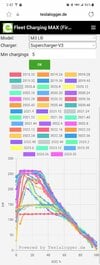Videomatic3
Member
Employee computer. Only thing I could do is ask him to take a picture of the screen and im pretty sure he's not allowed to do that.Where does it say it supports 300kW charging?
I'm also going to point out that this isn't the first time tesla has software locked the model 3. It was first at 125kw then 150, later unlocked to 250. But this was more obvious due to the flat charging as shown in teslalogger.de with the older software versions. Now we are waiting for the full potential of a v3 charger or v4 charging, which I really cannot say. I wouldn't mind having a vin number for a German built model y with the LG battery to look it up too
Attachments
Last edited:



